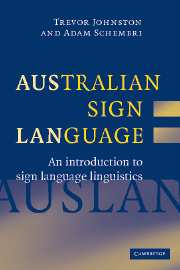Book contents
- Frontmatter
- Contents
- Acknowledgements
- Conventions for sign notation
- 1 Signed languages and linguistics
- 2 Auslan in social context
- 3 Auslan and other signed languages
- 4 Phonetics and phonology: the building blocks of signs
- 5 Morphology: sign formation and modification
- 6 Lexicon: the structure of Auslan vocabulary
- 7 Syntax: the structure of sentences in Auslan
- 8 Semantics and pragmatics: sign meaning and sentence meaning
- 9 Discourse: structure and use above the sentence
- 10 Issues in the study of signed languages
- References
- Index
2 - Auslan in social context
Published online by Cambridge University Press: 02 December 2009
- Frontmatter
- Contents
- Acknowledgements
- Conventions for sign notation
- 1 Signed languages and linguistics
- 2 Auslan in social context
- 3 Auslan and other signed languages
- 4 Phonetics and phonology: the building blocks of signs
- 5 Morphology: sign formation and modification
- 6 Lexicon: the structure of Auslan vocabulary
- 7 Syntax: the structure of sentences in Auslan
- 8 Semantics and pragmatics: sign meaning and sentence meaning
- 9 Discourse: structure and use above the sentence
- 10 Issues in the study of signed languages
- References
- Index
Summary
In the previous chapter, we saw that signed languages are now recognised as real languages. In this chapter, we place signed languages in their social context and describe how language use in signing communities differs from that found in spoken language communities. For example, we explain how signed languages are often only found as primary languages in deaf communities which are small linguistic minorities embedded within much larger communities using spoken languages. These spoken languages, in turn, often have written forms, which are used by literate signers. The types of signed communication that evolve in deaf communities given this relationship between signed and spoken (written) languages—such as natural signed languages, artificial sign systems and natural sign systems (Fischer, 1998)—is explained in this chapter. Importantly, the question of variation in signed language is also examined.
The deaf population, the deaf community and the Auslan-using population
Only a very small percentage of the Australian population is severely or profoundly deaf. The prevalence of deafness in developed societies has long been estimated to be about 0.1 per cent of the population (i.e., one in one thousand people) (Schein, 1968; Schein & Delk, 1974). If this were the case, there would be approximately 20,000 deaf Auslan users out of a population of approximately 20 million in 2005. The precise number of signing deaf people in Australia is, however, unknown. Published estimates have ranged from as low as 7,000 (Power, 1987) to as high as 30,000 (Deaf Society of NSW, 1989).
- Type
- Chapter
- Information
- Australian Sign Language (Auslan)An introduction to sign language linguistics, pp. 27 - 52Publisher: Cambridge University PressPrint publication year: 2007
- 1
- Cited by



